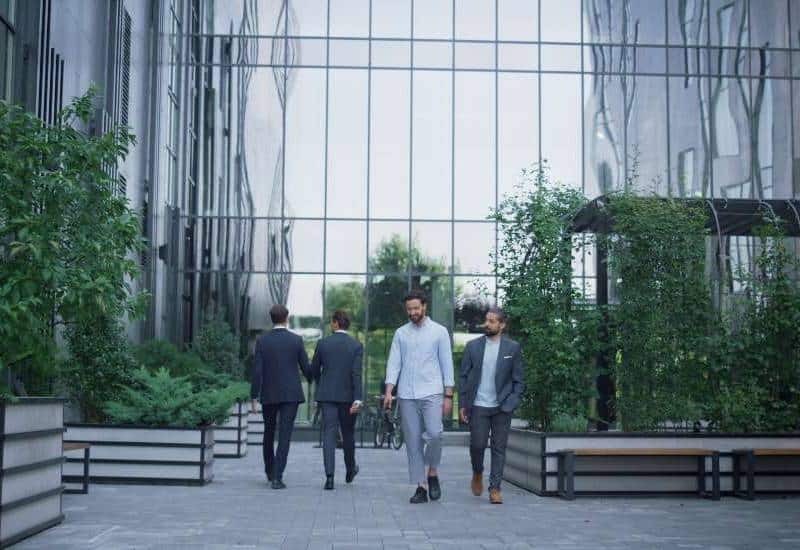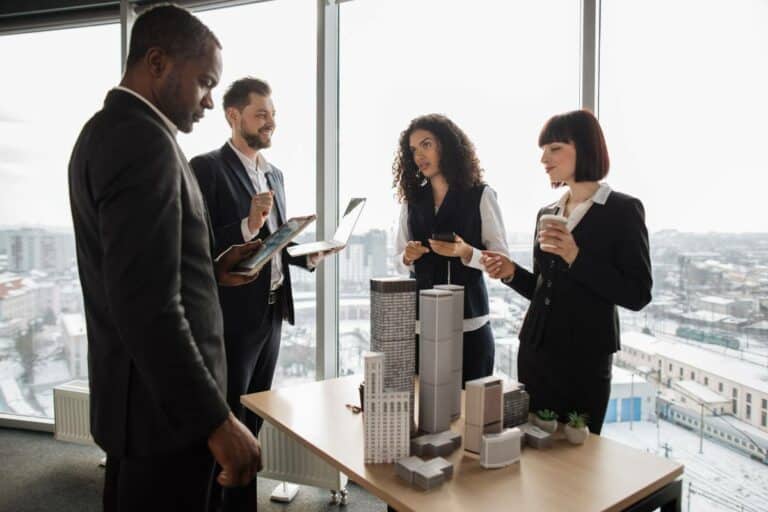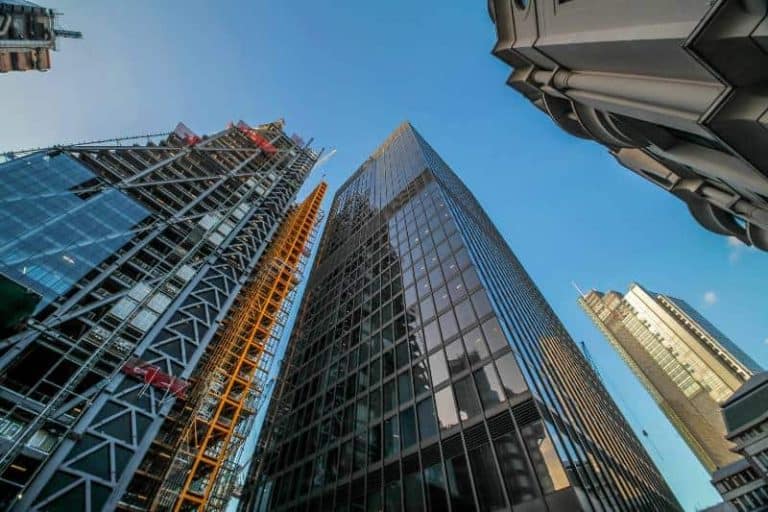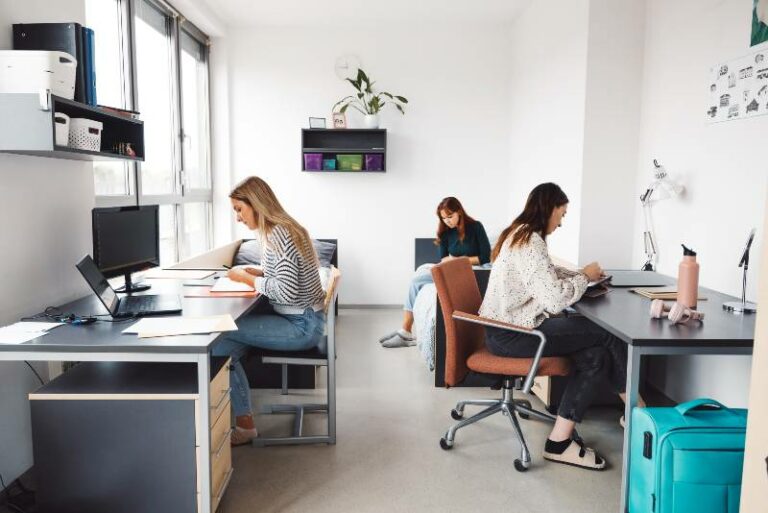Green initiatives have become an increasingly popular topic in many industries, with the commercial real estate sector being no exception. As the benefits of green projects become increasingly clear, more and more companies are making a commitment to incorporate sustainable principles into their real estate investments.
The purpose of these types of initiatives is to make better use of available resources, minimising the environmental impact of your commercial real estate, and improve overall efficiency and performance. From improved indoor air quality to increased energy savings, industrial green initiatives can bring significant value to any commercial real estate industry.
Not only do they provide valuable financial returns, but they also support sustained long-term development while protecting the environment. Companies considering implementing green initiatives should evaluate their projected impacts on the triple bottom line: environmental sustainability, profit-generating potential, and social responsibility.
As a nation, we are becoming increasingly concerned with the effects of climate change. The good news is that there are many things we can do to mitigate these effects, even in our everyday lives. One way to be part of the solution is by making sure your commercial green real estate is as environmentally friendly as possible.
Key Takeaways
- Green initiatives are becoming increasingly popular in commercial real estate. These initiatives can bring significant value to any commercial real estate industry by improving indoor air quality, reducing environmental impact, and increasing energy savings.
- Commercial green real estate investments should be evaluated for their projected impacts on the triple bottom line: environmental sustainability, profit-generating potential, and social responsibility.
- By making sure your commercial green real estate is as environmentally friendly as possible, you can be part of the solution in mitigating the effects of climate change.
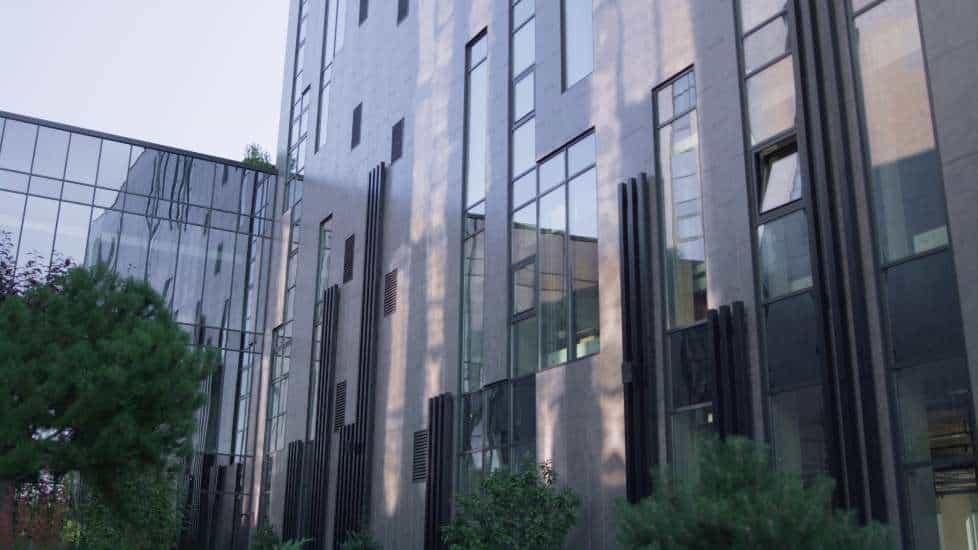
Environmental Benefits
Reduction in Carbon Footprint
According to Weforum.org, Vivid Economics says that it will cost $5.2 trillion just in the next 10 years to remove carbon from the built environment. To be in line with the Paris Agreement and give ourselves the best chance of keeping temperature increases to 1.5 degrees Celsius, the built environment must aim to cut carbon emissions by 50% by 2030 and be carbon neutral by 2050 at the latest.
Green commercial real estate has become increasingly popular, not just because of its financial benefits but also for its environmental advantages. By investing in energy efficiency, businesses can significantly reduce their carbon footprint and support a move toward a sustainable future. Advances in green building materials, such as renewable wood products, have made eco-friendly buildings more accessible than ever before.
Businesses should capitalize on this trend to make sure that they are on the right side of history by taking active steps toward creating greener buildings. By enacting these progressive measures now, businesses will not only benefit the environment but enjoy positive returns over the long term.
Conservation of Natural Resources
The power of green is immense, with the potential to dramatically communicate a company’s commitment to sustainability and environmental responsibility.
It is also an important aspect of modern commercial real estate, as businesses strive to maintain corporate integrity while reducing emissions and energy usage. As such, taking steps towards greening up a building can have significant positive effects on not only the environment but also on a property’s value and market standing.
Green architecture has many benefits, such as increased energy efficiency, decreased carbon emissions, and conservation of natural resources. Not only does this result in reduced operating costs but it also increases employee satisfaction who may prefer working in more sustainably conscious spaces. The power of green is undeniably tremendous when it comes to transforming commercial real estate.
Improved Air and Water Quality
According to smart-cre, real estate is responsible for more than 40% of global energy consumption and 30% of greenhouse gas emissions. Most of these resources are consumed during the operating phase of buildings. As a result of material production and demolition, construction and demolition are responsible for large amounts of waste and pollution.
So, we acknowledge that commercial real estate has a powerful role to play in reshaping our collective environment. By making intelligent, sustainable design choices, green commercial buildings can reduce and be carbon-neutral commercial properties, improve air and water quality, and foster healthier and happier communities.
Through energy efficiency upgrades and renewable technologies, building owners have the opportunity to significantly improve their environmental footprint while generating economic savings over time due to lower operating costs. With increased public awareness about the importance of corporate sustainability and responsible environmental practices, the power of green is transforming commercial real estate.
If you aren’t that familiar with Commercial real estate trends for 2023 yet but want to learn, make sure to read this article here, where I discuss the key factors that could influence the sector this coming year. From economic shifts to technological advances, I explain what you should be aware of in order to make informed decisions when investing in commercial real estate.
Economic Benefits
Cost Savings through Energy Efficiency
Commercial real estate is increasingly powered by green energy, creating powerful economic benefits for owners and tenants alike. Businesses that transition to green energy sources can realize significant cost savings through improved energy efficiency and reductions in utility bills. Not only does this translate into immediate financial gains for businesses, but it also gives them the opportunity to invest their capital elsewhere. As these cost savings accumulate, businesses are provided with more resources to grow and expand their presence in the commercial real estate market.
Increased Asset Value and Rentability
Commercial real estate is one of the most sought-after commodities in the modern economy. Investing in green solutions, not only has a positive environmental impact but also beneficial economic returns. Studies have revealed that applying green improvements to commercial real estate can result in higher rental rates and ultimately, an increase in asset value.
Investing in green technologies has become increasingly attractive to investors due to the potential for higher financial rewards; making increased energy efficiency and sustainability a point of focus. Tapping into the power of green not only generates cost savings for owners but also provides numerous advantages for tenants and the environment as a whole.
Improved Marketability and Brand Reputation
The Power of Green is undeniable as businesses of all kinds continue to recognize the positive benefits what commercial property sustainability can bring. In terms of commercial real estate, it can provide a hefty economic return.
Investing in green upgrades to buildings, such as energy-efficient appliances and fixtures, automated controls, renewable energy sources, and more can have tremendous financial payoff through reduced energy costs and increased marketability of the property.
Furthermore, developing sustainable practices in the company’s brand reputation will enable them to stand out from competitors by demonstrating its commitment to environmental stewardship. Companies that strengthen their eco-conscientious image will likely experience higher levels of consumer adoption and loyalty.
Social Benefits
Improved Health and Safety for Building Occupants
Commercial real estate is being renovated and re-imagined with the help of green design. This is bringing about a shift in the industry, providing numerous social benefits for building occupants.
Investing in green infrastructures such as energy efficiency measures helps to reduce greenhouse gas emissions, improve indoor air quality, and reduce energy bills. In addition, it increases health and safety by eliminating toxins or contaminants in the environment, improving lighting, and removing allergens or irritants.
With these advantages, building occupants will experience greater comfort and productivity while corporations benefit from long-term cost savings related to maintenance and repair costs.
Enhancement of Community Image
Commercial real estate has the power to revolutionize communities, providing a sense of identity and pride all while making both environmental and economic contributions. Through creative color schemes, energy efficiency initiatives, and other design elements green buildings can help shape their surroundings while also treating people with care — creating safe living environments that benefit public health. Not only are such choices healthier for the planet but they may even bring substantial financial benefits in terms of higher leasing rates or lower operating costs – driving an ever-increasing interest towards eco-friendly solutions within commercial realms.
The attraction of a Responsible and Sustainable Tenant Base
Investing in green commercial real estate brings tremendous social benefits. Buildings constructed with eco-friendly standards not only reduce their environmental impact but also provide more comfortable, healthy workplaces for tenants. This can help to attract a responsible and sustainable base of tenants who are mindful of their impact on the planet and desire working spaces that align with their values. By investing in green solutions, businesses can meet customers’ evolving expectations of corporate responsibility and create a stronger tenant base as a result.
Implementation of Green Initiatives and Sustainability Trends in Commercial Real Estate
Energy-Efficient Design and Construction
Depending on factors like scale, location, and market, the design of an environmentally friendly commercial structure can take several forms. However, there are some general strategies for energy-efficient building design that can be implemented in almost any structure. These can be boiled down to two basic factors: the materials used and the viewpoint taken.
Taking into account the structure as a whole is a good place to begin. This method involves all parties engaged in the design and construction of the structure, from the owners and other stakeholders to the architects and the eventual occupants. When designing a building from the ground up, it’s important to consider the needs and wants of a wide range of people and examine how each part of the structure affects the others.
Having a solid building shell that has been carefully designed is priority No. 1.
The building envelope is often overlooked yet is crucial to a building’s overall energy efficiency. According to energy.gov, energy used for heating and air-conditioning accounts for more than 25% of the primary energy consumed in commercial buildings. The efficiency of the heating and cooling system is dependent on the building envelope. The HVAC system won’t function as efficiently as possible if the building envelope has poor insulation or isn’t designed for the structure’s location and dimensions.
Driving with a faulty envelope is like operating a vehicle with a leaking gas tank. However full the tank is, you are not getting your money’s worth if petrol is pouring out the bottom.
A method that takes into account the entire structure is very helpful here. Designing an envelope that is optimized for energy efficiency requires taking a step back to take in the big picture of the structure and how it will be used and occupied. Using sustainable insulation solutions like cellulose, cotton, or even sheep’s wool is also crucial.
2) Energy-Efficient Heating, Ventilating, and Air-Conditioning Improving heating and cooling efficiency requires a high-quality building envelope and an equally effective heating and cooling system.
The more the area that must be cooled or heated, the greater the importance of sustainability in real estate and of the HVAC system. Larger buildings often incur greater heating and cooling costs, although this can be mitigated by the application of design strategies that prioritize energy efficiency.
The efficiency of heating, ventilation and air conditioning (HVAC) systems can be improved by paying attention to details like demand-controlled ventilation and central heating systems as opposed to individual ones. A lot of HVAC units will also feature an energy efficiency rating that can assist customers to decide which model is ideal for their structure.
In addition, it may come as a surprise to learn that ceiling fans can also contribute to reduced energy consumption. Ceiling fans reduce the load on the HVAC system by facilitating more uniform air distribution.
Making the Most of the Sun’s Energy
Making the most of available natural light is a crucial component of many successful energy-efficient structures. Taking full advantage of natural light is a great strategy to reduce energy consumption in business buildings, yet the sun doesn’t cost a dollar to use. A few methods exist for doing so, the most common of which is the use of windows and strategic building orientation.
The building should be positioned so that the rooms that require the most light for the longest period of time face south, where sunshine is accessible for the longest part of the day. Large, strategically placed windows and reflective surfaces (like white paint) on the ceiling and walls will do wonders for letting in the light. For instance, white ceilings are ideal because they reflect light better than any other color. If properly planned, natural light can be used to effectively light up huge clusters of cubicles.
To further improve energy efficiency, special coatings can be applied to windows that will change their emissivity in response to the weather outside.
Some windows, such as thermochromic and electrochromic varieties, can change their color in response to the sun’s intensity and temperature. Similar to how specially glazed windows are more effective at preventing heat and cold from escaping from the outside, standard windows do not perform a good job of keeping the temperature within a building constant.
Solar panels are being installed in an increasing number of structures. For instance, all of the homes in the largest 3D-printed community, located in Texas, have solar panels installed on their roofs. While solar panels may not result in net energy savings, they do reduce a structure’s reliance on nonrenewable sources of power. They reduce expenses in this area because they generate some electricity “in-house.”
Use of Renewable Energy Sources
Commercial real estate is a critical sector of the global economy, and its environmental impact cannot be overstated. To ameliorate this, there are a number of environmentally responsible practices that have been adopted when it comes to design and construction in recent years.
These include energy-efficient design techniques and the use of renewable energy sources such as solar and wind power. By embracing these practices, commercial real estate has tremendous potential to not only reduce its environmental footprint but also reap significant financial rewards. The power of green is truly transformative when it comes to commercial real estate.
Building Management Systems and Technologies
With its expansive rooftops and open spaces, commercial real estate presents the ideal canvas for harnessing renewables like solar and wind. And the financial incentives are stacking up as quickly as the environmental ones. From lower operating expenses to higher property values and improved branding, going green pays dividends across the board.
Yet renewable adoption remains low across the sector. Just 7% of commercial rooftops host solar panels, leaving untapped potential in virtually every market. The land sits vacant and could support wind and solar installations. Constraints like high upfront costs, split incentives between owners and tenants, and lack of financing options are holding back progress.
The tide is turning, however, as innovators lead the way. Companies like NRG and SolarCity are pioneering financing products that eliminate upfront costs for property owners. Startups are aggregating portfolios of distributed solar projects to achieve economies of scale. Investor pressure and strengthening regulations also raise the bar.
The business case speaks for itself – Verizon’s 7MW solar project at a California office park will slash $90 million of the utility bill over 30 years. Retailer Kohl’s solar arrays save $2 million annually. And campus-style commercial developments are tapping geothermal, biomass, and biogas solutions as sustainably heels renewable growth.
The potential of commercial real estate to minimize environmental impact is profound. With smart policies, innovative funding mechanisms, and increasing adoption of solutions like eco-friendly landscaping, optimized solar orientations, and advanced green building materials, commercial real estate is positioned to tap its full renewable potential. The result will be resilient, self-reliant properties delivering returns to both tenants and owners while powering communities sustainably for generations to come.
Sustainability In Commercial Real Estate FAQs
What are green initiatives in industrial commercial real estate?
Actions That Can Be Taken Easily To Improve The Environment At The Office
- Put it in a recycling can and prod others to utilize it.
- The rule of thumb is to boil as much hot water as you will use.
- When not in use, turn off the lights or the power.
- Purchase bean bag filling that isn’t harmful to the environment.
- Challenge your staff to go green.
- Pick a can over a glass.
Why is it important to adopt green initiatives in this sector?
There are several eco-friendly practices that your business can adopt to boost efficiency and cut expenses. It might be as easy as installing motion detector lights or as involved as installing a solar power system.
What are the environmental benefits of green initiatives in industrial commercial real estate?
Commercial real estate sustainability may be enhanced if more environmentally friendly structures are introduced to the property market. They prevent pollution, improve air quality, and save energy expenses. These buildings also lessen environmental damage by cutting down on energy use and pollutants.
How do green initiatives in this sector save costs for building owners and tenants?
Water and energy efficiency in sustainable office buildings reduces utility bills for owners, while also benefiting building developers through reduced construction costs and increased property value, and business owners through enhanced employee productivity.
What is the impact of green initiatives on the health and safety of building occupants?
Green initiatives in commercial real estate can lead to improved air quality, less noise pollution, and better temperature regulation, which can all contribute to improved health and safety for building occupants. Additionally, by reducing energy consumption, these initiatives can help reduce the risk of fire due to overheating.
Conclusion
Despite some hesitations and challenges, it is important for business owners and organizations to adopt green initiatives whenever possible. The benefits of doing so – reducing your carbon footprint, saving money on energy bills, and improving the health and safety of those inside the building – are too great to ignore. Implementing these changes can seem daunting, but there are plenty of resources and support available to help you get started. Give me a call or schedule a free consultation today, and we’ll be happy to answer any questions you have or help you get started on your journey to being more sustainable.
Blog Articles Disclaimer
The information presented in articles on our website or affiliated platforms is exclusively intended for informational purposes. It’s crucial to grasp that this content does not constitute professional advice or services. We strongly recommend our readers to seek guidance from appropriately qualified experts, including, but not limited to, real estate and other attorneys, accountants, financial planners, bankers, mortgage professionals, architects, government officials, engineers, and related professionals. These experts can offer personalized counsel tailored to the specific nuances of your individual circumstances. Relying on the content without consulting the relevant experts may hinder informed decision-making. Consequently, neither Tolj Commercial Real Estate nor its agents assume any responsibility for potential consequences that may arise from such action.
